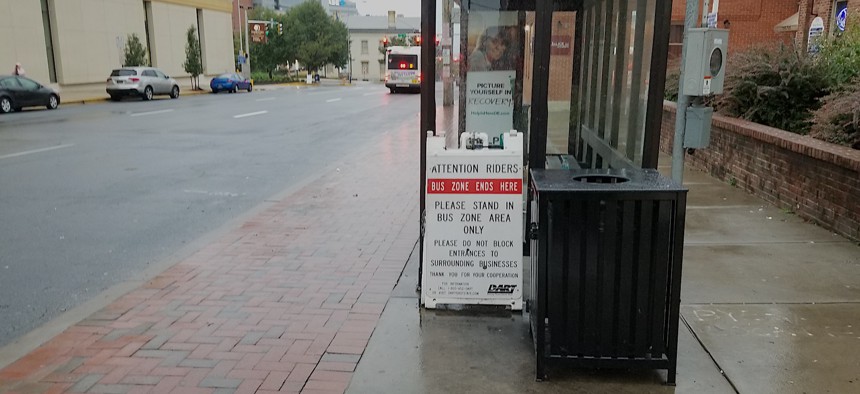Looking at Bus Stop Improvements and Transit Ridership Impacts

DART wants its bus riders to steer clear of local businesses along King Street in downtown Wilmington. Michael Grass / Route Fifty
While research is limited, one study found that “improved bus stops are associated with a statistically significant increase in overall ridership and a decrease in paratransit demand.”
WILMINGTON, Del. — Just down the way from the Bus Stop Market at Eighth and King streets in Delaware’s largest city, there’s a sign on the sidewalk that requests passengers stand only within the confines of the adjacent bus zone area and not wait in the doorways of nearby businesses.
It’s not a request you see at most transit stops around the nation. In Wilmington, bus shelters—or the lack of them in some cases—have been a pressing issue. Businesses, as The News Journal reported in August, have long wanted the bus hub at Rodney Square—in the heart of downtown—to go away, a controversy that’s “been tinged with racial and class overtones.”
When DART buses that served the Rodney Square hub were relocated to other downtown stops in December, some commuters were left to wait on narrow sidewalks that lack shelter when it rains. That includes one heavily used stop on Orange Street, just south of 10th Street, that didn’t look like a particularly inviting place to wait for a bus when Route Fifty walked by on Friday evening.

But last week brought the first physical signs of hope that bus commuters in Delaware will be getting improved places to wait in downtown Wilmington. The Delaware Transit Corporation, the state agency that runs DART bus service, started installing sleek new shelters along King Street, the first of many planned for the downtown area.

“Following recent bus route changes in downtown Wilmington, we heard and listened to concerns about the need for additional benches and shelters for our riders, and that’s the reason we are making these important investments,” Gov. John Carney said in a statement. “We believe that affordable public transit and transportation infrastructure improvements are key to investing in our city and Wilmington’s downtown area.”

The newly installed King Street bus shelter, just south of Ninth Street, has a distinctive Y-shaped design and was funded as part of $116,000 in bus shelter improvements in the downtown area. DTC has $300,000 in additional improvements planned for the next fiscal year.
That’s a relatively modest investment. Pricey new bus shelters can come with controversy. Officials in Arlington County, Virginia saw significant blowback when they planned to roll out “super” bus stops that came with a $1 million price tag, a sticker shock that turned into a tortured saga that stretched on for years. On the other end of the spectrum, there’s no shortage of awful—and sometimes dangerously located—bus stops that are done on the cheap.
But does an improved bus stop boost ridership? That’s hard to say definitively due to limited research on the topic.
In March, the University of Utah’s Department of City and Metropolitan Planning released a report it prepared for the Utah Department of Transportation’s research division that looked at bus stop improvements made by the Utah Transit Authority in the Salt Lake City area.
Transit best practices often emphasize the importance of a well-designed bus stop. “How a stop is designed and constructed sends important signals to the public about the transit agency’s attitude toward existing and potential riders—are they to be valued, facilitated, and coaxed into riding, or merely accommodated,” the University of Utah researchers wrote.
The study found that “improved bus stops are associated with a statistically significant increase in overall ridership and a decrease in paratransit demand, compared to the control group stops. Specifically, between 2013 and 2016, improved bus stops saw ridership increases that were 92% higher than increases at the control group stops, while also experiencing ADA paratransit demand increases that were 94% lower than at the control stops.”
But the report acknowledged the limitations of the study, including geography. So, while “it would be tempting to view the ridership increase as supporting a conclusion that improving bus stop amenities leads to increases in overall bus ridership,” the researchers wrote that more examination is needed.
The impacts on the demand for paratransit service, however, are “[p]erhaps the most important finding from the study.”
Bus stops that lack a level pad hinder or prevent wheelchair access, forcing those with mobility impairments to instead use paratransit services, which are expensive for government agencies to operate. Improved, accessible bus stops reduce that demand since those in wheelchairs can use regular transit services, reducing the need for paratransit service.
Michael Grass is Executive Editor of Government Executive’s Route Fifty and is based in Seattle.
NEXT STORY: Demystifying PaaS: The missing piece to digital transformation






